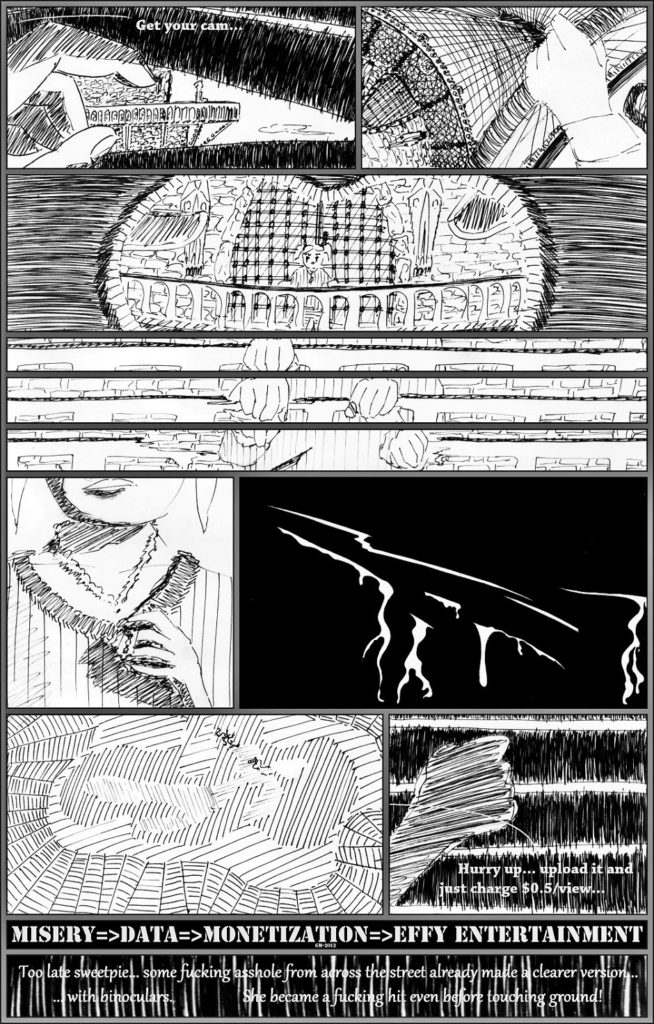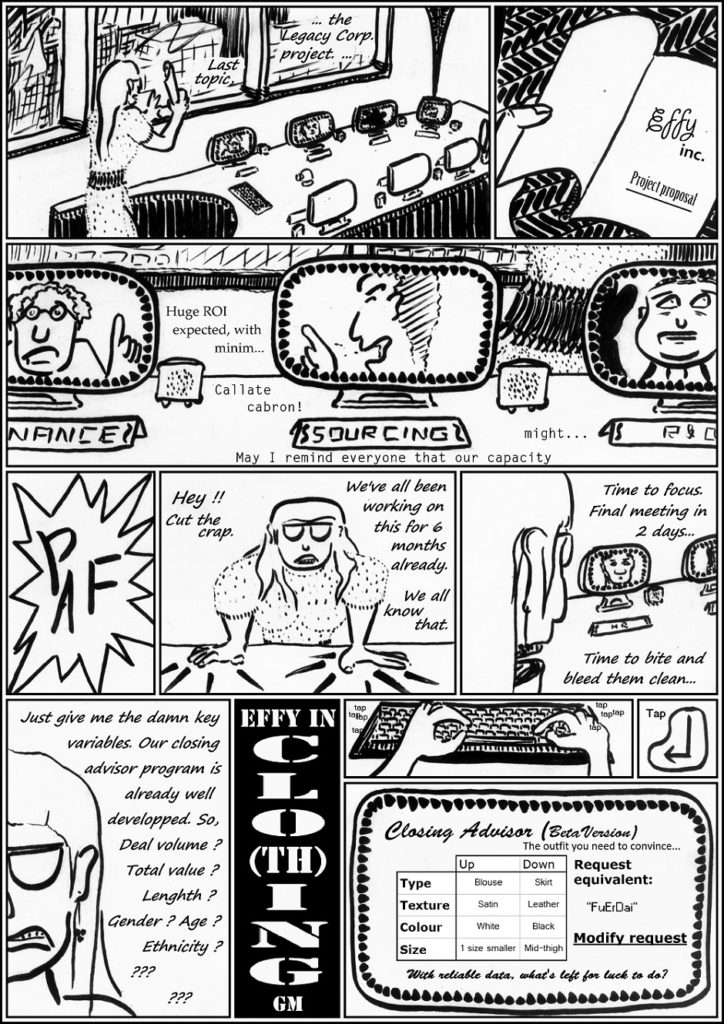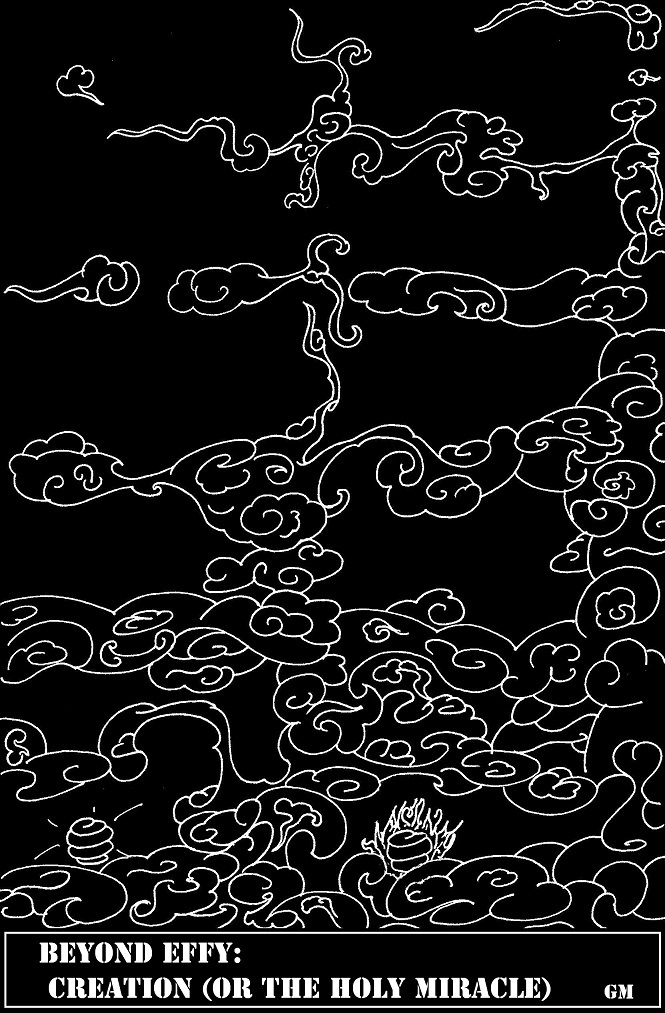Batch eleven of Effy – The living efficiency is set in a darker and more mystical world, must be the fall season weighting on G.M.’s mood. Get ready for killing truth, suicidal misery or business lust… even creation ends up very black!
Don’t miss his weekly updates on Effy’s own page or through Tapas!
For lack of better solutions, efficiency is defined by its measuring units. In effect, measuring units act like filters, distorting, focusing and limiting efficiency analysis. So using light’s behavior as example, let’s have a quick look at how important the choice of unit is to ensure coherent efficiency analysis.
(A big thanks to Marb’s creator for his thoughts on efficiency, and introducing me to Fermat’s principle; this is a follow-up to previous articles dealing with efficiency analysis such as Clit Eastwood).
Fermat’s principle & light efficiency
In optics, Fermat’s principle states that “a ray of light passes from one point to another in such a way that the time taken is a minimum” (from the free dictionary, I am not a physics expert, so I kept the definition very simple, but more accurate definitions can be found here and here).
So it means that lights always seek the fastest way, but not necessarily the shortest. From an efficiency point of view, the process decreases the use of time, and can be seen as optimized measured in time unit. Meanwhile, it does not necessarily decrease the distance traveled, and can therefore be seen as non optimized, measured in distance units.
For a visual representation, lightnings are never straight lines!
This logic applies to any subjects of efficiency study.
Efficiency analysis:
Choice of units; choice of focus
So, before analyzing any process, framing the field of analysis and defining the right measurement method is vital. Financial efficiency translates all inputs and outputs in cash. Energy efficiency uses kwH. A production line might use items/time, or scrap/batch. All are both relevant and irrelevant, it depends on the angle you wish to study.
Choosing units will reduce the field of analysis, and doing so, will clarify the topic. And choosing the wrong unit will render the analysis pointless (the number of CSR reports assessing actions’ efficiency in terms of cash never cease to amaze me).
Interpreting results & Developing solutions
The choice of unit has a double edge. It makes the analysis possible, however, it will only highlight one side of the process efficiency. So never forget the assumptions made by the choice of unit, or you might overlook important conclusions. What we can take from light’s example is that very often, efficient path are not straight or obvious ones. If light were to go for the shortest distance, it would take a longer time. So light naturally chose to focus on speed when following a path.
Similarly, if you measure your life efficiency in terms of earnings / day or in terms of laughs / day, results and decisions to optimize it could be drastically different.
Effy’s episode in all that?
Alike light’s twisted path to efficiency, truth also has a way to strike very hard, very fast, and often through unexpected ways. As for aesthetic, it’s Halloween, so couldn’t resist to have some seasonal spirit…
A quick take on entertainment efficiency, and symptoms of an uncontrolled framework. Meanwhile, wealth gap is widening almost everywhere around the world… fueling the cycle.
Centralization of channels and framework
The time of internet’s virgin land is long gone. Boundaries and policies now delimit the cyber space. Popular channels and platform must now abide to localized regulations for good or bad, corseting what can be diffused. Rules vary between places, but the logic of a tightening grip on the ability to access a stand, and voice an opinion is however the same.
Other channels or independent domains are simply out of reach, without a fair chance to be found.
Captive audience
Taking advantage of their unique position, channels developed strategies to tighten their grip over their audience. They propose more and more content, yet with less and less diversity, creating polarized world. Everyone can become an expert on specific theme, and yet be completely ignorant on some fundamental knowledge. So audience’s creative and cultural environment shrinks, even though a wide range of knowledge is available. Channels do just that, they channel to create captive audience…
In the end, the public taste becomes very specific, following clear genres, with defined tropes and creative elements. This cluster that is seldom exposed to anything else, no longer comprehend cross genre and multi-referencing.
Struggling creators & Cost reduction
On the other side of the message, creators’ role slowly lose value. Channels business model isn’t selling content, but selling data and ‘brain space’ (quoting the president of french first tv channel M. LeLay). So content has little value, and their creators get very little for their contributions. Yet, with captive audience, creators only have two choices: abide to popular genre that channels defined and try to get exposure; or create original content, and remain in the shadow.
This made content sourcing less and less costly for channels too, as creators are now queuing to provide content shaped just for them for free.
Effy entertainment
In the end, audience effectively gets what they want. Similarly, new creators born and raised in this paradigm, are happy to get any exposure they can. Channels cash in, and investing some back to tighten their grip along the way…
Meanwhile, wealth gap widens. Audience relies on escapism that channels provide to forget misery, while creators shape their creations to fit new norms with the hope to get views .
Then what?
As of today, very few alternative exist, and the one available such as unregulated space (like dark web), or space with fair treatment are technically out of reach or illegal. So this is what it is…
Second episode about negotiations, following ‘Tioli’ which was centered on bargaining. This time, the episode focuses on efficient sales closing techniques.
Within the selling process, closing refers to the final step, when the client finally enters into a legally binding agreement. Salespersons use a wide variety of techniques to help “closing the deal”, and Changing Minds listed some of the ones on their website (and no, this is not a sponsored link or anything, but a genuine recommendation). Closing techniques are obviously useful to sell products or services, but they can also serve to sell ideas or opinions. As such, they are very important for argumentation or persuasion as well.
Despite Changing Minds’ comprehensive listing, there’s no mention of the technique that Effy uses in this episode. She developed a program that generates a salesperson’s clothing set perfect to close a deal, based on clients’ key variables.
And from nothing came something; the paroxysm of efficiency. Scientists are investigating the origin, the mystery that separate 0 and 1. Religions offer their versions, without tangible evidences to back it up. But one thing remains: as it is, any creation from naught to something would be the most efficient process of all time…
(This is the third episode around efficiency and faith, following GMO & WWED)












